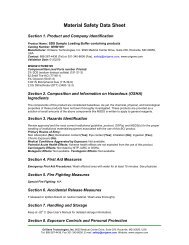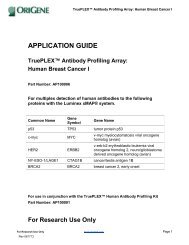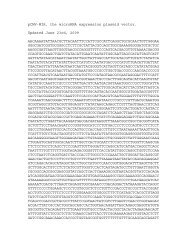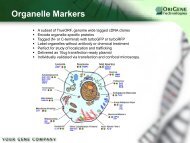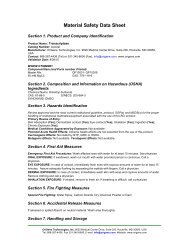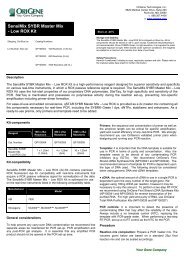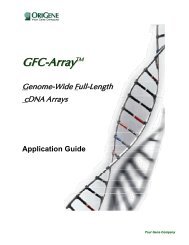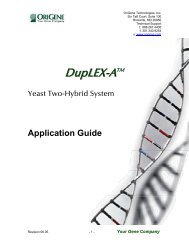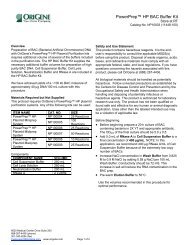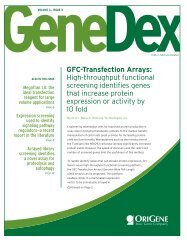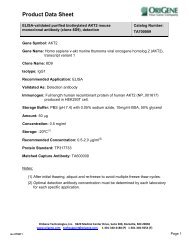shRNA and shRNA vectors - OriGene
shRNA and shRNA vectors - OriGene
shRNA and shRNA vectors - OriGene
You also want an ePaper? Increase the reach of your titles
YUMPU automatically turns print PDFs into web optimized ePapers that Google loves.
Continued from Page 9<br />
the tube by scraping the surface with a pipet tip, <strong>and</strong> deposit it<br />
in a sterile culture tube containing LB-amp. The culture should<br />
be incubated overnight at 37°C with agitation before proceeding<br />
to step 4.<br />
Step 4. DNA preparation<br />
<strong>OriGene</strong> provides a plasmid preparation service for all of<br />
our HuSH-29 customers. To receive larger quantities of each<br />
plasmid, use catalog number DNA05 to receive 5 ug of each<br />
construct for the price of $100 USD each ($400 USD for all 4).<br />
Miniprep method (for producing up to 40 ug plasmid from<br />
5 mL liquid culture)<br />
Isolate DNA from the liquid cultures by using your preferred<br />
method. <strong>OriGene</strong> routinely uses Marligen’s High Purity Plasmid<br />
Miniprep Kits or similar systems. Follow the manufacturer’s<br />
protocol for isolation, <strong>and</strong> elute the DNA in 50 uL of TE [10 mM<br />
Tris-HCl (pH 8.0), 1 mM EDTA]. Determine the concentration of<br />
each sample, <strong>and</strong> store the DNA at -20°C.<br />
Midiprep method (for producing up to 500 ug plasmid from<br />
100 mL liquid culture)<br />
Add 5 mL of liquid culture grown several hours or overnight to<br />
a sterile flask containing 95 mL of LB-amp. Incubate overnight<br />
at 37°C with agitation. Isolate DNA from the liquid culture using<br />
your preferred method. <strong>OriGene</strong> routinely uses Marligen’s<br />
High Purity Plasmid MidiPrep Kits or similar systems. Follow<br />
the manufacturer’s protocol for isolation, <strong>and</strong> elute the DNA in<br />
4 mL of TE [10 mM Tris-HCl (pH 8.0), 1 mM EDTA]. Determine<br />
the concentration of each sample, <strong>and</strong> store the DNA at -20°C.<br />
Introduction of gene specific <strong>shRNA</strong> into<br />
mammalian cells via transient transfection<br />
Transient transfection is the simplest method of introducing<br />
HuSH-29 constructs into your target cells. <strong>OriGene</strong> recommends<br />
transfecting each HuSH construct separately as well<br />
as all constructs together into an easily transfectable cell line<br />
(such as HEK293T or NIF3T3 cells) to determine the construct<br />
or pairing of constructs that produces the most complete<br />
knockdown effect, before proceeding to work with a more<br />
retractable cell line or primary culture.<br />
Step 1. Plate cells<br />
The day before transfection, passage cells into the desired cell<br />
container. Plate an amount of cells expected to achieve 50-<br />
80% confluency on the following day (see Table I for examples).<br />
Grow the cells overnight at 37°C in a 5% CO 2<br />
incubator.<br />
Step 2. Prepare transfection mixtures<br />
Dilute the transfection reagent* into serum-free medium<br />
without antibiotics (Invitrogen’s OptiMEM solution is a good example).<br />
Do not let the transfection reagent come into contact<br />
with the side of the tube; instead, pipet the reagent directly<br />
into the medium. Gently flick the tube or pipet up <strong>and</strong> down to<br />
mix. Incubate for 5 minutes at room temperature. Follow the<br />
manufacturer’s recommendations for ratios <strong>and</strong> volumes of<br />
reagent <strong>and</strong> DNA (see Table II for examples).<br />
*Many commercially available transfection reagents are<br />
convenient for transient transfection. Choose a reagent that<br />
is compatible with your target cells. <strong>OriGene</strong> routinely uses<br />
lipid based transfection reagents such as FuGENE 6 or Lipofectamine<br />
2000 on HEK293T cells for validation experiments,<br />
<strong>and</strong> the protocol here is based on those manufacturers’ recommendations.<br />
Be sure to follow the specific protocol for your<br />
transfection reagent.<br />
HuSH-29 constructs are ideal for<br />
use on hard-to-transfect cells <strong>and</strong><br />
cells lines, thanks to the option of<br />
retroviral infection.<br />
Dilute the plasmid DNA into serum-free medium without<br />
antibiotics. Gently flick the tube or pipet up <strong>and</strong> down to mix.<br />
Combine the tube of reagent/medium with the tube of DNA/<br />
medium, <strong>and</strong> gently mix. Incubate for 15-45 minutes at room<br />
temperature.<br />
10



